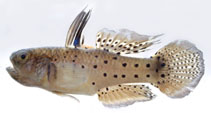| Family: |
Gobiidae (Gobies), subfamily: Gobionellinae |
| Max. size: |
9 cm SL (male/unsexed) |
| Environment: |
benthopelagic; freshwater; brackish; pH range: 7 - 8; dH range: 9 - 19, amphidromous |
| Distribution: |
Asia: India, Sri Lanka and the Andamans to Singapore and Indonesia. |
| Diagnosis: |
Dorsal spines (total): 7-7; Dorsal soft rays (total): 7-8; Anal spines: 1-1; Anal soft rays: 7-8; Vertebrae: 26-27. Body pearly grey with three or four roughly aligned rows of round black spots along the sides; bases of soft dorsal and anal fins with elongate spots and streaks (aligned with fin rays); elongate blackish spot on first dorsal fin between third to fifth dorsal fin spines; presence of interobital and post-orbital pores, preopercular pores. Second dorsal rays I,7-8. Anal rays I,7-8. Pectoral rays 18-21. Longitudinal scales 25-29. Transverse scales backward 8-10. Predorsal scales 7-10, reaching behind eyes (Ref. 56945). |
| Biology: |
Occurs in estuaries and tidal zone of rivers. Prefers fresh water, rarely found in brackish water. Feeds on small fishes and invertebrates, including mosquito larvae (Ref. 12693). |
| IUCN Red List Status: |
Not Evaluated (N.E.) Ref. (130435)
|
| Threat to humans: |
harmless |
Source and more info: www.fishbase.org. For personal, classroom, and other internal use only. Not for publication.

